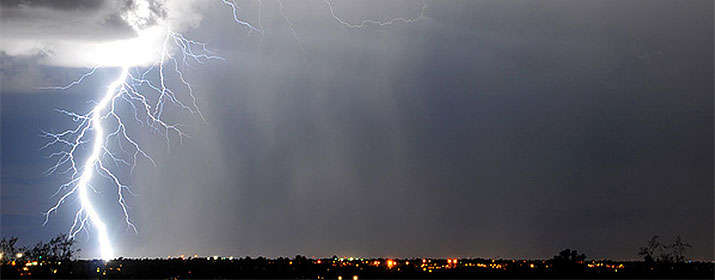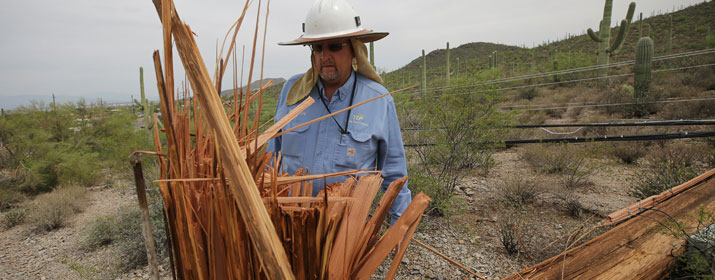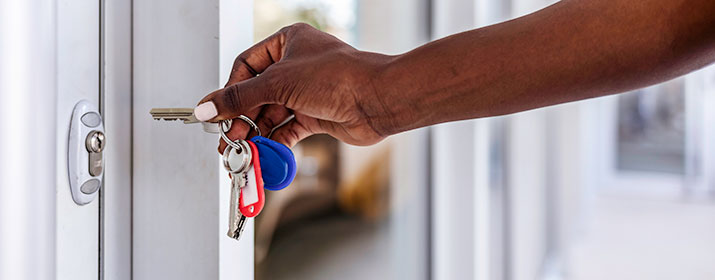
While short-term outages are an inconvenience, extended outages from monsoon storm damage can have a larger impact. Just as Tucson Electric Power prepares all year long for storm season by fortifying our electrical system, customers also can prepare to ensure they’re safe and sound if the lights go out. Here are 10 steps to take so you’re ready, no matter what the weather brings:
1. Ready an emergency kit
Long before our first severe storm, assemble an emergency kit with essential items your family will need. Your kit should contain a battery-powered radio, flashlights, fresh batteries, a first aid kit, nonperishable food and drinking water– one gallon a day for each person in the household. And don’t forget that your pets also need food and fresh water.
Good nonperishable food choices include crackers, dried fruit or trail mix, beef jerky, canned or pouches of chicken or tuna and granola bars, all of which have a longer shelf life. To avoid stumbling around in the dark and possibly hurting yourself, have several light sources, such as a battery-powered flashlight and lantern. Don’t use candles, which can tip over and start a fire.
“If you have an emergency kit already, this is the perfect time to update items by checking expiration dates on food and the power levels of batteries,” said Brian Herman, TEP’s Director of Corporate Safety.
2. Watch the weather
Follow weather forecasts on the TEP mobile app or tune into local radio and TV stations so that you’ll be aware if severe weather is developing and can prepare. Before storms hit, secure patio furniture and umbrellas and loose objects to prevent their damage and flying debris. Sign up for free weather alerts from NOAA, the National Weather Service and Pima County Emergency Management to stay informed of severe weather warnings.
3. Have backup communications
If landline phones are out or your home’s wireless phone needs electricity, your cell phone may be your only communication tool – until the battery runs out of juice. Investing in a solar cell phone charger can help you recharge and make calls in an emergency. Some devices store energy, while others can only provide a charge if the sun is shining on the solar cell. Most devices cost less than $50.
To extend your phone’s battery life, turn off background applications, notifications and streaming service or just power it down until you need to use it. In a pinch, use your vehicle’s power outlet with your phone charger to boost your battery or to power other electronics.
4. Turn off your AC
TEP recommends that you turn off your air conditioner during a power outage. Why? Well, it’s not doing you any good without electricity anyway … but the real reason has to do with what happens when the power comes back on.
When service is restored to a section of our grid that suffered an outage during hot weather, every air conditioner in that area that wasn’t turned off starts up at the same time, trying to get all those warm homes and business back to a comfortable temperature. The problem is that AC units require additional power at the moment they start – much more than they use while operating. The combined impact of hundreds or thousands of AC units starting up at the exact same moment can trigger reliability problems that cause another outage or even damage your AC unit.
Turning off the AC helps protect your unit and our grid. It also provides an opportunity to burn a few extra calories walking back to the thermostat to turn it back on after service is restored.
5. Use surge protectors
Lightning strikes during a monsoon storm can sometimes cause power surges that can damage electronics plugged into outlets. Using smart power or surge strips for your television, gaming station and other electronics will protect them from these spikes. You’ll also be protected from the impact that phantom energy can have on your electric bill.
6. Stay away from downed power lines
Downed power lines can still be energized and deadly, even if they look harmless. Always stay far away from downed lines, call 911 to report them and keep others away from the area.
Never drive over a downed power line or attempt to get out of your car if a power line has fallen on it. Call 911 and wait for help. If you must get out of the vehicle for some reason, here’s how to do that safely:
“Open your door and jump out and away from the vehicle being careful not to touch the car and the ground at the same time,” advised Roger Hall, TEP Manager of Transmission & Distribution. “Both feet need to be touching and together when you land or shuffle with your feet close together until you are at least 20 feet away from the vehicle.”
7. Stay cool in extreme heat
Outages that occur during extreme heat can pose a real health concern without air conditioning. Drink plenty of water to stay hydrated and wear loose clothing made of a breathable fabric. Consider buying a few battery-powered fans, which are remarkably effective at moving air to make it feel cooler. Using gel-filled cooling neck wraps also can help lower your body temperature. Simply wet the wrap and slip it around your neck for a cooling effect.
In extended outages, check TEP’s outage web page for updates, details about community cooling centers that may have been set up and other services available in affected areas.
8. Minimize food loss
Keeping the refrigerator and freezer closed will safely keep food cold for about four hours. Adding bags of ice also will extend the cooling time. Once the freezer begins to warm, transfer frozen foods into a cooler with ice. If the temperature of the food is higher than 40 degrees for two or more hours, it’s best to throw out the food rather than risk getting sick.
Here’s a trick to know whether your food may have spoiled during an extended outage. Place a cup of water in your freezer. After the water freezes, place a coin on top of the ice. If you later find that coin below the ice’s surface, you’ll know the food in your freezer and fridge thawed at some point and the food is likely unsafe to consume. When in doubt, throw it out!
Something you can do before an outage is to fill milk jugs with fresh water and place them in your freezer. This will not only help keep your food cold during an outage, but they also can be thawed to provide fresh drinking water.
9. Know your medical options
If you rely on an electronic medical device or have refrigerated medications, talk with your medical provider about having a power outage plan. Find out how long your medication can be stored at higher temperatures and get specific guidance for any medications that are critical for life. Possible options might be having a backup generator to power your refrigerator or medical device, using an ice chest for temporary storage or going to the home of a friend who has power.
TEP customers with medical devices that require electricity are encouraged to enroll in our Medical Device Alert program. Customers in this program are kept informed about the status of service interruptions and the estimated time of restoration.
10. Prevent electrical hazards during flooding
Monsoon storms often are accompanied by heavy rains and flooding. “Never use electric appliances or touch electric wires, switches or fuses when you’re wet or when you’re standing in water,” Hall suggested. “Keep electric tools and equipment at least 10 feet away from wet surfaces and don’t use electric yard tools if it’s raining or the ground is wet. Electricity and water don’t mix well.”
For more power outage readiness tips, visit the websites of FEMA, American Red Cross and the Arizona Department of Homeland Security.






